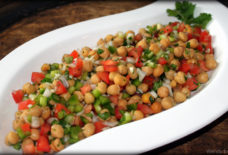Ghraybeh: Humble shortbread cookie appears around the world, but with local twists
By: Blanche Shaheen
Source: Los Altos Town Crier
When Americans think of the shortbread cookie, they often imagine the traditional Scottish cookies, shaped like oblong rectangles and served at teatime. However, there are countless variations of this humble sweet in the Middle East, Persia and Africa, dating back to the seventh century, when sugar became more accessible.
There are as many varieties of this cookie as there are spellings, from sekerleme in Turkey to kourabia in Armenia and ghraybeh in Lebanon, Syria, Palestine and Jordan.
Ghraybeh is the shortbread I grew up with, shaped into diamonds or the letter “S” – the latter being why many Arab-Americans also call them “S Cookies.” My siblings and I would wait anxiously to eat these S cookies as my mother baked them, filling the house with the intoxicating scent of browned butter.
Why such wide regional popularity for the simple shortbread-style cookie? The answer is a melt-in-your-mouth texture and elegant simplicity that appeals to most taste buds.
Middle Eastern shortbread differs from its European counterpart in the use of ghee, or clarified butter, instead of regular butter. The ghee imparts a pleasant, sweet flavor and doesn’t harden the cookie the way butter does. Ghee also increases the shelf life of the cookie, because the milk solids have been removed. While my mother and grandmother would spend hours melting a dozen sticks of butter to make clarified butter, I find that store-bought ghee imparts the same authentic flavor with less mess and time. Today ghee is much easier to find, available in most supermarkets. Cookies made with ghee are baked at a lower temperature than European shortbread, 300 degrees, so that they don’t crack and turn brown.
Unlike traditional American shortbread, ghraybeh should be a pale cream or even yellow color rather than browned. I add a touch of rosewater for that authentic Middle Eastern flavor and smell, but you can substitute any extract you wish, from vanilla to almond and even orange blossom water. Traditionally the cookies are topped with blanched almonds, but you can use any nut of choice, from pistachios to pine nuts and walnuts, or no nuts at all. The cookies are also egg-free, so they are great for children with egg allergies.
This Mother’s Day I will be paying back the baking favor by making my mom a batch of these nostalgic confections, which go perfectly with a cup of strong Arabic coffee or black tea. Dusting these cookies with powdered sugar also gives them a festive touch, great for tea parties, showers or christenings.
For more of her recipes with a Middle Eastern twist, visit feastinthemiddleeast.com.
MIDDLE EASTERN SHORTBREAD
• 1 cup superfine sugar
• 2 cups flour
• 1 cup clarified butter or ghee
• 1/2 teaspoon rosewater (optional)
• 1/4 cup pine nuts, blanched almonds or pistachios
Preheat oven to 300 F.
Sift flour and set aside. Beat ghee 5 minutes or until fluffy and nearly white in color. Add sugar and rosewater and beat 1 minute. Add flour gradually on low speed, one-half cup at a time, scraping sides with spatula as needed. Cover dough in plastic wrap and refrigerate 1 hour.
On lightly floured surface, roll dough into logs with fingers, approximately 4 inches long and 1 inch wide. Shape each roll into the letter “S.” You can also roll out dough and shape into circles, ovals or diamonds. To shape into diamonds, roll dough into log approximately 1 inch in width, then flatten with fingers. Cut diagonally into diamonds. Place a nut in center of each cookie.
Bake 20 minutes. Do not overbake, and do not let cookies brown. Allow cookies to cool for at least an hour. Remove carefully with a metal spatula and sift powdered sugar over the cookies to serve, if desired. Ghraybeh keep frozen or in an airtight container for up to two weeks.








